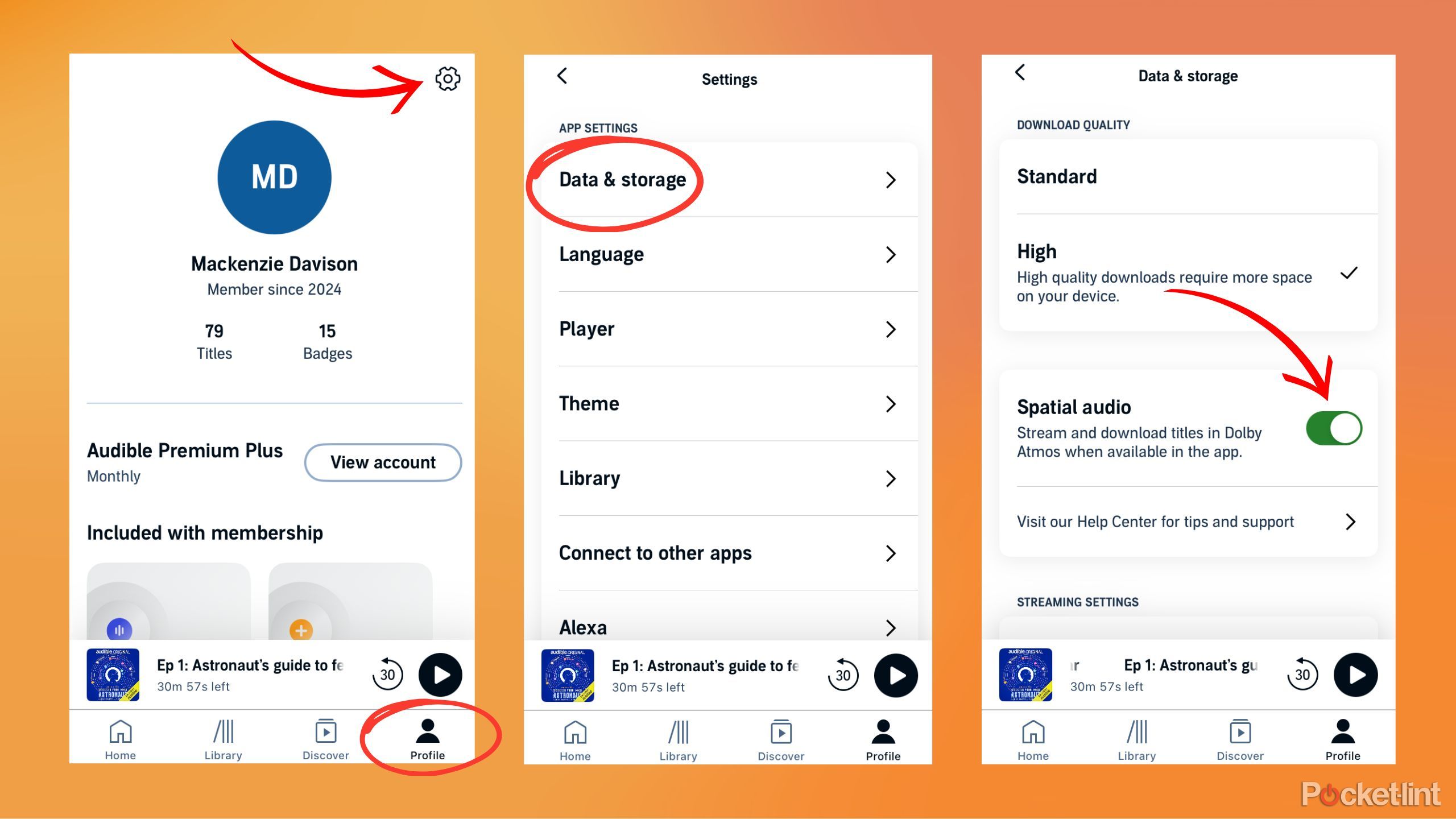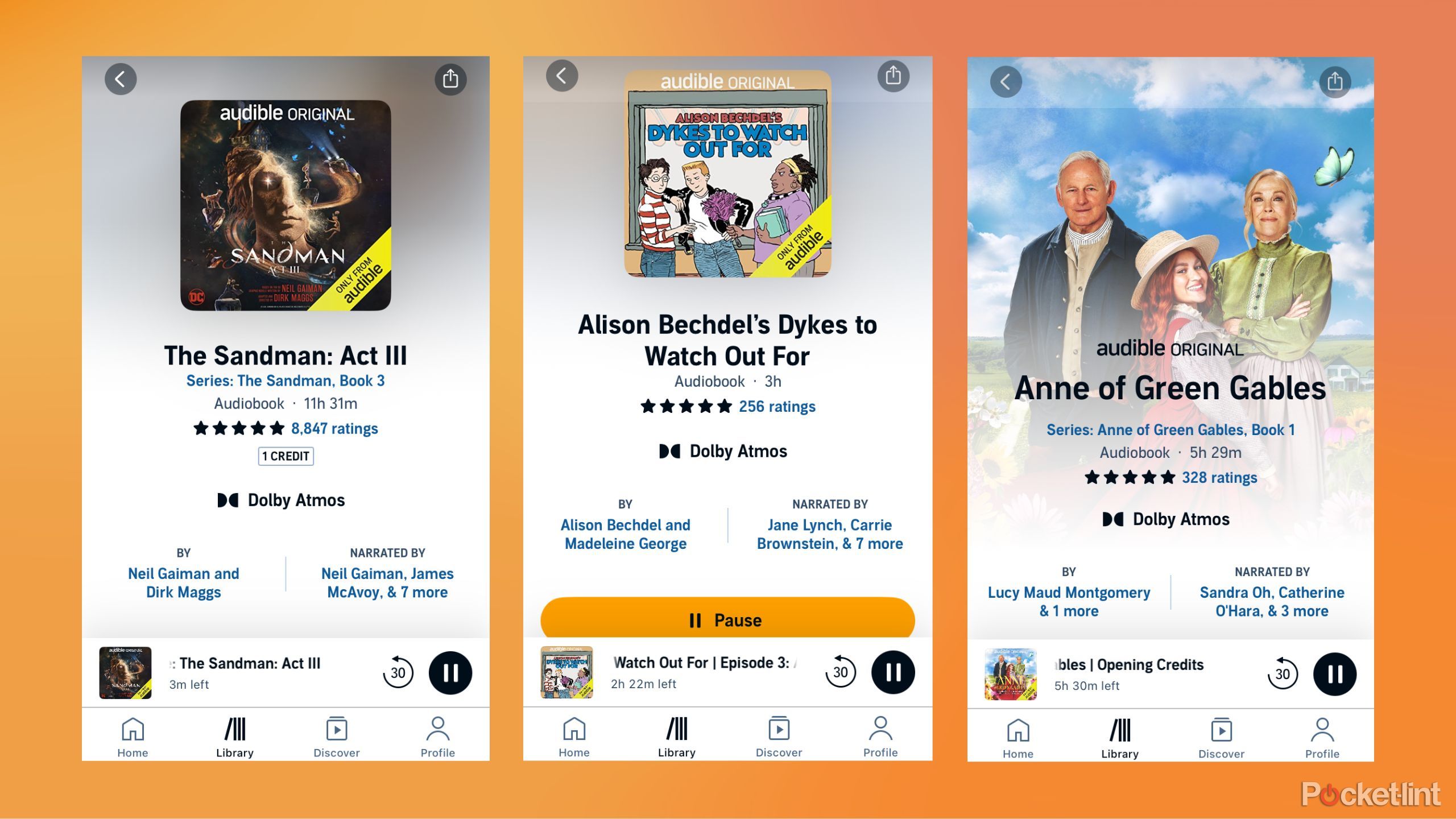
I tried Audible’s Dolby Atmos audiobooks, and they sound better
Key Takeaways
- Listening to Dolby Atmos audiobooks on Audible offers immersive, 3D sound for a captivating experience.
- Accessing Dolby Atmos audiobooks on Audible requires turning on spatial audio and using supported devices.
- Dolby Atmos titles on Audible enhance storytelling with full cast productions, but a wider selection and expansion are desired.
Amazon’s Audible partnered with Dolby Laboratories to bring a new level to immersive storytelling in 2023. Audible is already a preferred way for many to listen to audiobooks, and since last year it’s added another draw, bringing Dolby Atmos sound to enhance their stories and put you at the center of the action.
Dolby Atmos is ultimately a spatial sound technology, which adds height channels to a traditional surround sound presentation which creates a 3D, immersive sound. You should hear and even feel the sound around you and overhead. Most Dolby Atmos audiobooks feature full cast production and narrative sounds on-top of the spatial sound tech, immersing listeners in the stories in new ways.
 Related
Related
Does Dolby Atmos actually sound any better? Here’s what it can do
Dolby Atmos takes surround sound to another level and gives you cinematic sound from the comfort of your home.

Dolby Atmos makes a difference on Audible
I spent the last month working my way through the Dolby Atmos collection on Audible, and as an audiobook fanatic, I’m impressed.
Truly improved experience
Specifically, in the adapted works like David Copperfield by Charles Dickens and A Streetcar Named Desire by Tennessee Williams, the audio surrounds and improves the experience in a way that made me feel like I was at a live stage production. Voices came from the right of my head for some characters, above or left for others, with gradual atmospheric sounds like wind, rain, doorbells, etc. building throughout the stories.
“The audio surrounds and improves the experience in a way that made me feel like I was at a live stage production.”
The echo of Stanley Kowalski yelling “Stella!” caused me to literally jump and laugh as I bodily returned to my college round table read-aloud. The long classic tomes and plays are particular feasts for the ears, allowing users to experience them closer to their intended performance format. I might never see Streetcar live, so I’m taking it as a huge win that I experienced it in this medium.
I don’t consider myself the highest form of audiophile, and I’m definitely not a sound snob, but as a librarian and now technology editor, I finish two to three audiobooks a week. According to my Libby app history, Audible listens, and StoryGraph user data, I have averaged a little over 100 audiobooks a year for the past eight years — I know good audiobook production.
One caveat to note
One caution about whether the Dolby Atmos sound on Audible is worth it; it stuns when listened to on headphones, but isn’t as impressive on most of my standard speakers. Dolby Atmos is generally intended for surround sound systems, with recent innovations bringing it to personal devices. I find the Audible titles sound best through headphones, unless you prefer to use your phone as a Bluetooth source for a home theater surround sound set-up. Most audiobook listeners I know use their commutes to catch up on books, so I tested it both in my car and with my headphones walking about.
If you spend your commute listening to audiobooks, I have two recommendations:
- If you walk or travel by train or bus with headphones, I beg you to try it.
- If your commute is by car, the speakers likely won’t create a better sound than a standard audiobook dramatized production — especially in my 2016 Subaru Crosstrek. It was enjoyable and still great storytelling, but that wasn’t the tech output it was designed to dazzle on.

Essentials for Audible Dolby Atmos listening
You need to subscribe to Audible to access Dolby Atmos-enabled audiobooks –most are available at no further cost than your monthly subscription. Then, you need to turn on spatial audio in settings and ensure you have a device that supports Dolby Atmos.
Turn on spatial audio on Audible
- Go to your Profile.
- Select the Settings gear.
- Select Data & storage.
- Swipe Spatial audio’s toggle to green.
Make sure your device can play Dolby Atmos
You will need a supported device to play Audible audiobooks with Dolby Atmos playback. There is a full list of devices on Audible’s support page. Since most folks use mobile devices to listen to Audible, we’ve broken down a few of the popular devices below.
|
Platform |
Device Compatibility Details |
|---|---|
|
Apple (iOS 15.1 or later) |
|
|
Android |
|
|
Kindle and Fire Devices |
|
Headphones are highly recommended
Technically speaking, the built-in speakers on an iPhone XS or later (except iPhone SE), iPad Pro 12.9-inch (3rd generation or later), iPad Pro 11-inch or iPad Air (4th generation or later) can play back Atmos natively. But more generally, most smartphones don’t house enough speakers to make use of Dolby Atmos, so I advise using Audible with any pair of headphones you have on hand, and this should offer a good experience.
Some of Apple’s headphones can optimize Audible’s Dolby Atmos further, with iOS Dynamic Head Tracking. If you activate it, the sound changes in real time based on which way your head is facing, for the most realistic experience possible. Supported headphones with Dynamic Head Tracking as a bonus, include AirPods (3rd generation), AirPods Pro, AirPods Max, or Beats Fit Pro.
 Related
Related
How Apple’s Spatial Audio offers realistic 3D listening on most AirPods
Spatial Audio helps you get more out of Apple’s earbuds. Here’s how.
Finding Audible’s Dolby Atmos audiobooks
Once you have a device that can play Dolby Atmos, you simply need to load up the Audible app or website and search in its catalog for supported titles. They don’t jump out on the Audible homepage, so try one of these three options to find them quickly.
- Type Dolby Atmos into the search bar to see a list of compatible titles.
- While browsing, if a title has the Dolby Atmos badge underneath it, you can see at a glance that it is supported.
- Look for the ‘Listen in Dolby Atmos’ carousels that you’ll sometimes see on the Audible Discover page for inspiration.
If you’re already listening to a title that has since been updated to include Dolby Atmos, you will have access to the updated soundtrack immediately — just click play and the updated version will be streamed. Whichever method you locate the Dolby Atmos collection the first time, I recommend you add it to your Audible library collection for easy access in the future.
For downloaded books, you will need to re-download the title to get the updated Atmos version — but you won’t lose your listening position when you do, thanks to WhisperSync.
File size: Dolby Atmos soundtracks will be larger file sizes than regular audiobook downloads (which are already pretty hefty). If you’re streaming your audiobook, be mindful of your data usage if you’re not connected to Wi-Fi — if you’re downloading, just make sure you have space on your device.
Audible’s Dolby Atmos collection is limited
There are currently 81 titles available on Audible. You can see the full, and most up-to-date, list of titles on the Audible website.
But what’s available is worth it
You can get through the catalog of audiobooks very quickly if you listen to even a couple of books a month. The titles in the Dolby Atmos collection are not necessarily all audiobooks. Audible offers original podcasts and sleep playlists in this collection as well. I particularly enjoyed listening to the titles that I had previously read or listened to in a more traditional format. While limited, there are mystery, thriller, romance, science fiction, classics, and contemporary genres available, so most listeners should find a title to their liking.
“Audible and Dolby are likely hedging their bets to see if folks pick up on the Dolby Atmos quality and invest, but I’d love to see greater depth for selection and even other audiobook companies benefit from my new favorite immersive story-telling format.”
I’d previously read Gaiman’s The Sandman Act III, Bechdel’s Dykes To Watch Out For, and Montgomery’s Anne of Green Gables. Dolby Atmos brought Bechdel’s sharp wisdom and humor to the highest clarity, made me weep and laugh with Anne, and dropped me right in the land of dreams with Morpheus in The Sandman. The classics were given a breath of new life and I believe every English Language Arts teacher in the US should replace their classroom hardcover copies with the Dickens productions. However, there’s just not a lot of content yet, and a lot of it is aimed at Middle Readers.
These are expensive to produce, mix, and master. I’m hoping for the unlikely future in which Dolby comes to agreements with other companies to increase offerings. Deals with dramatic adaptation audiobook publishers like Recorded Books or GraphicAudio — the company behind the viral and successful full cast, abridged adaptations of Sarah J. Maas’s series — could hugely expand the Dolby catalog.
Audible and Dolby are likely hedging their bets to see if folks pick up on the Dolby Atmos quality and invest, but I’d love to see greater depth for selection and even other audiobook companies benefit from my new favorite immersive story-telling format.
FAQ
Q: Do Dolby Atmos audiobooks on Audible cost extra?
Of the 81 Dolby Atmos titles available on Audible, I found only five would cost an additional Audible credit to purchase. The rest are included in an Audible Plus or Premium Plus subscription through the catalog. Audible Plus is $7.95 per month and lets you listen to thousands of included titles in the Plus Catalog. Audible Premium Plus is $14.95 per month and includes the Plus Catalog plus 1 credit per month for any premium selection title.
Q: What’s the difference between Dolby Atmos and Dramatized Adaptation?
Audiobooks tend to have slightly more nuanced definitions of immersive audio in regard to spatial audio — the technology Dolby Atmos falls under. Especially on Audible, you may see content described as immersive audio, Dolby Atmos, or dramatized adaptations. Dramatized adaptations have become interchangeable with the brand GraphicAudio, so you may also see graphic audio as a term.
In the audiobook world, think of immersive audio as any technology or format that enriches the audio experience to create a more realistic, enveloping storytelling. Immersive audio is the umbrella term that spatial audio lives under, of which Dolby Atmos is a specific type of and often regarded as the gold standard. But in terms of audiobooks, immersive audio doesn’t necessarily mean spatial audio.
When you see dramatized adaptations noted in Audible, nine times out of 10, this is describing an immersive audio format that uses a full cast of voice actors, music, and abridged storytelling through atmospheric sound instead of narrative. Instead of the narration describing the wind howling, the audiobook will play a howling wind sound. These features are often found in Dolby Atmos productions, but dramatized adaptations likely don’t use Dolby’s spatial audio.
One of the major publishers, GraphicAudio, has become synonymous with dramatized adaptations due to hugely successful recordings over the last year, and they do not use Dolby Atmos. There are over 1,700 dramatized adaptations on Audible, but currently, there are only 81 DolbyAtmos titles, and they are all produced by an Audible studio, not GraphicAudio.



